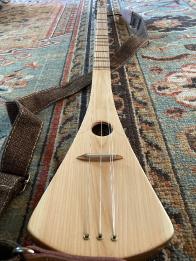Scalloped Fingerboard Designin' Blues...
Hi all, new to the site and to dulcimer building, figured I'd make my first post start with a banger of a question.
First off, a little background to put the question in context. I've both a musical and woodworking background, and over the past few months (as I've gotten into instrument building and general lutherie technique) I've binged a lot, and I mean A LOT, of instrument building info, from tone wood selection and pairing to bracing and soundboard tonal refinement, heck, even french polishing technique (did I mention I was a total nerd too and over-research everything I'm interested in?)
Anyhow, when it comes to dulcimers - depending on whether you want to build historical, old-school (folk revival period) or modern there are a myriad of options that exist today for soundboard/fingerboard/bridge configuration. Especially over the past 50 years, there has been a blooming of construction techniques and experimentation with regards to the fingerboard-to-soundboard relationship from what I've seen in my digging around the internet. I'm still on the fence as far as which structural combo I'll use on my first dulcimer build, but in all my poking around for information I started to notice a trend and I'm wondering if it's coincidence or if there's some purposeful acoustic reason behind it.
What I noticed was predominately on scalloped or vaulted fingerboards - while I saw some variation in construction, ie. # of scallops and size of scallops, there were a great many that followed this pattern as far as the size of the vaults from the nut down -
big, medium, medium, small (like in this pic ) or
big, medium, medium, medium (like in this pic ).
Whatever the cause, for some reason I picked up on this pattern, and would have thought it just coincidence until I saw this pic and this pic from David Beede's site. Granted, David's making cutouts under a hollowed fingerboard and floating tailpiece, but he still has this larger-to-smaller pattern in his openings like with the scalloped fingerboards. Curious, right?
As it would happen, the dulcimers I was able to listen to with this distinct patterning in their construction were more pleasing to my ear than others. Since I happened to watch a few videos on guitar bracing and sounding a while back it got me thinking - Are people building fingerboard/soundboard configurations with this spacing on purpose because it gives better tonal quality (ie. the larger to smaller scallop spacing naturally falls on specific tonal points of the soundboard thus allowing fuller sound from the soundboard), or is this an unconscious response from builders honing in on an acoustics driven design through trial and error over time? Or is this all completely coincidence and I'm just hearing/seeing things?
Sorry for the length, and if you made it this far through my ramblin' I hope y'all might be able to shed some light on this.
-Kevin

